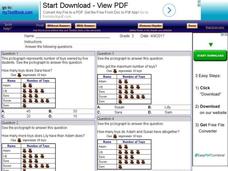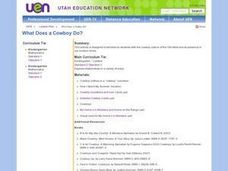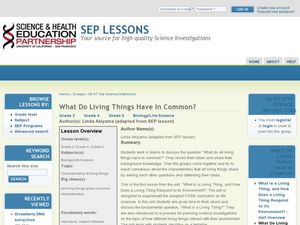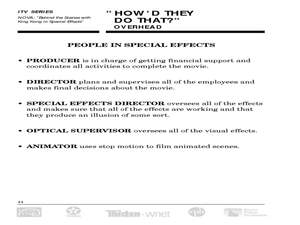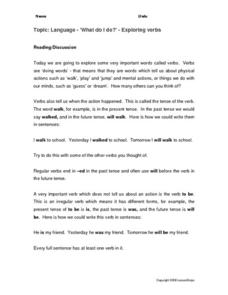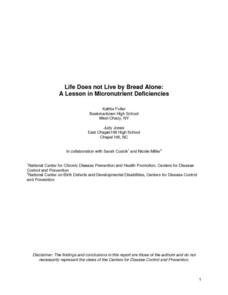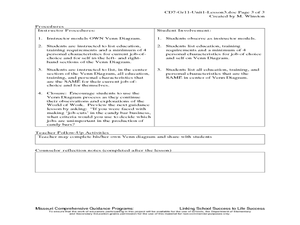Curated OER
What Does My Bacteria Look Like?
Students identify Gram positive and Gram negative bacteria using staining techniques. Students research importance of identification of bacterial types in diagnosing bacterial diseases.
Curated OER
How Does a Seed Grow Into a Plant?
Second graders explore how seeds grow into plants. They discuss types of seeds and place seeds in wet paper towels to germinate. They draw a picture in their journal to record their observations for four days. They take pictures of their...
Curated OER
Where Do I Belong? Shape Activity
In this shape worksheet, learners color shapes that belong with a group, and write an X on shapes that do not. A variety of shapes are used, 6 sets total.
Curated OER
Using Pictographs With Data
In this using pictographs with data worksheet, 3rd graders read data from a pictograph to answer ten multiple choice questions. Answers can be shown on the screen.
Curated OER
How Does It Sound?
Young scholars play game that uses the elements of grammar in an inappropriate way, and transform the inappropriate grammar into grammatically correct statements.
Curated OER
Do You Like the Do?
Students explore different haircutting techniques and the tools used in haircutting. They practice cutting hair on a maniquin, give each other a trim to get rid of split ends and execute a specific cut as a culminating project.
Curated OER
Where Do We Get Clean Water?
Students investigate the concept of a filter. They use simple supplies in order to construct one after watching a demonstration performed by the teacher. An important warning that the project water is not clean for drinking is included....
Curated OER
What Does a Cowboy Do?
Students participate in a variety of activities as they study cowboys and the cowboy culture. They read stories and sing songs about the cowboys. They study the area of the United States cowboys are from and review the tools cowboys...
Curated OER
Problem-Solving Application: Use a Graph
In this problem solving worksheet, 6th graders use the problem solving steps of understand, plan, solve and look back to answer a graphing question.
Curated OER
What Do Living Things Have In Common?
Students explore the concept of classification. In this classification lesson, students collaborate to create lists of living thing similarities in order to differentiate between living and non-living things. Students create a list of...
Curated OER
Using Numbers in Everyday Situations
Students exercise the basic use of numbers in their everyday lives. For this numerical exercise, students discover the many ways numbers are used in everyday life. The students draw pictures showing examples of a time they have used...
Curated OER
How'd They Do That?
Students research the movie production occupation and careers in the industry. In this movie careers and effects instructional activity, students watch a video about special effects used in movies and scale. Students draw a building to a...
Curated OER
Topic Language- "what Do I Do?" -exploring Verbs
In this verb worksheet, 3rd graders read a selection on verbs and a short story. Students circle all of the verbs in the short story and sort them into a graphic organizer using present, past and future tense.
Creative Chemistry
Use of Common Metals
In this metals learning exercise, learners read about the different properties of aluminum, copper, and iron and determine why these metals are used the way they are. The exercise has five short answer questions.
Curated OER
Life Does Not Live By Bread Alone
Students investigate the relationship between micronutrients and proper metabolic function. The lesson should serve as an introduction to the subject. The subject of the function includes the study of plants, animals, and humans. They...
Curated OER
Minerals And Their Uses
In this minerals learning exercise, learners will review the four physical characteristics used to identify a mineral: streak, color, size, and hardness. Students will also understand the Mohs Hardness Scale. This learning exercise has...
Curated OER
What does the rice farmer use to get the rice to the mill?
Students use a ramp, sheet, and rice to demonstrate how rice farmers get the rice to the rice mill. In this rice lesson plan, students perform this experiment at home and answer short answer questions.
Curated OER
Using Imagery in Poetry
Students examine the use of imagery in poetry. In this literature lesson, students read "Thought of Hanoi," by Nguyen Thi Vinhand use the provided graphic organizer to chart the poem imagery. Students then describe the imagery found in...
Curated OER
Techniques Used to Convey Messages in Media
Students examine different types of media. In this media awareness lesson, students discover techniques used in print, language, symbolic, and technical media as they rotate through classroom station activities.
Curated OER
Weather Patterns and Acid Rain (or What is Chicago's acid rain doing in the Adirondacks?)
Students examine a color-coded map of U.S. acid rain precipitation intensity. Using EPA data table and the blank U.S. map, they record state-by-state values for magnitude of emissions and compare areas of emissions to areas with the most...
Curated OER
How Long Does Trash Last
Learners work in cooperative groups to estimate how long trash lasts in a landfill. They study environmental consequences of not recycling and use graph-making software to create a graph that illustrates the lifespan of trash items...
Curated OER
Rules for Using Commas
In this comma usage worksheet, students review when to use commas and then add commas, as needed, to twenty different sentences.
Curated OER
Does my career fit me?
Students create a venn diagram about the job they currently have and if they think it is what they should be doing. In this job lesson plan, students list education and job duties in a venn diagram and analyze if it is the correct job...
Curated OER
Auxiliaries- Be, Have, Do
In this auxiliaries worksheet, learners write negative and question sentences using auxiliaries be, have, and do. Students complete 22 statements.



